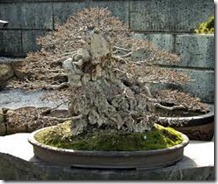 To understand bonsai history better, it is necessary to have a clear definition of what a bonsai is. “Bonsai” is a Japanese word, which when translated literally means “planted in a pot or container”. Bonsai refers to a set of methods and techniques in growing, shaping and caring for a tree with the intention of forming it into a miniaturized tree that bears a natural image of an ancient tree. Bonsai history shows that this horticultural practice has survived many centuries evolving into an art form.
To understand bonsai history better, it is necessary to have a clear definition of what a bonsai is. “Bonsai” is a Japanese word, which when translated literally means “planted in a pot or container”. Bonsai refers to a set of methods and techniques in growing, shaping and caring for a tree with the intention of forming it into a miniaturized tree that bears a natural image of an ancient tree. Bonsai history shows that this horticultural practice has survived many centuries evolving into an art form.
While the word “bonsai” itself is Japanese, according to bonsai history China was the birthplace of this art and that bonsai was derived from the Chinese word “pun-sai”.
The Chinese started pun-sai around 1000 BC, utilizing unique methods to cultivate trees in containers. During these ancient times, only the upper class in the society practice pun-sai and the miniature trees were given as luxurious presents.
Some historians think that the Chinese got the technique of miniaturizing trees and planting them in containers from Chinese healers who used the practice to transport medicinal plants. The earliest bonsai styles displayed trunks shaped like animals and mystical figures.
In bonsai history, it was at the time of the Kamakura period when Japan was adopting many Chinese cultural practices that pun-sai was brought to Japan. The Japanese then developed this practice of growing of trees in containers extensively, which is why the art of bonsai is usually credited to them. It was during the Heian period that the art of Bonsai spread around Japan.
During the Tokugawa era, landscape gardening was very popular in Japan and held a status symbol. It was the elite’s pastime to grow plants such as azaleas and maple trees. Then, bonsai or the cultivation of dwarf trees and plants in containers became popular but these small plants are actually quite large when compared to the bonsai we know today. Additionally, the Japanese did not refer to the miniature plants as ‘bonsai” until the late 1800s during the Meiji era. Before that, the Japanese called the dwarf trees in a pot “hachi-no-ki.”
The Japanese popularized bonsai and they were responsible for developing the techniques and styles that are still popular today. It was only during the 1900s that bonsai was introduced to the West.
Today, bonsai is a widely popular hobby and art form from Asia to the Western countries. There are shows, exhibits and auctions for bonsai. Aside from bonsai nurseries and bonsai specialty stores, there are also many bonsai internet resources where anyone interested can learn everything about bonsai from bonsai history to plant selection to styles, caring and many other topics. Indeed, this art form has never ceased to fascinate people all over the world and will continue to be passed on for more generations to come.

Deprecated: strpos(): Passing null to parameter #1 ($haystack) of type string is deprecated in /home/agriviek8Qv/agriviet.net/public_html/wp-includes/comment-template.php on line 2522